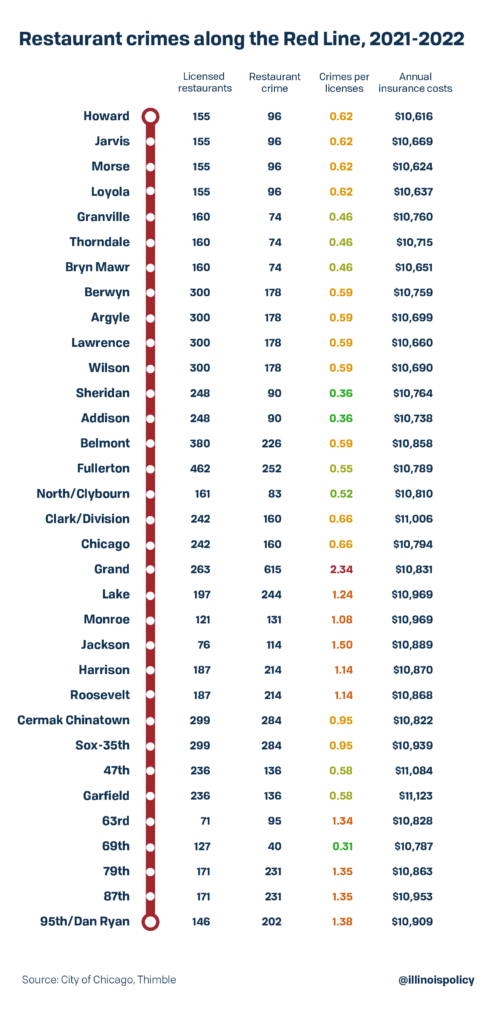Chicago restaurant crime along Red Line train highest near Loop stops
Each restaurant in the Chicago Loop along the “L” system’s Red Line averaged 1.2 crimes during 2021 and 2022, the most along the line. South of the Loop, there was less than one crime per restaurant.
The busiest route on the Chicago Transit Authority’s “L” system of elevated trains is the Red Line, with over 73,000 passengers a day covering 26 miles. The Red Line runs through the heart of Chicago from Rogers Park in the north, ranked as one of the five best neighborhoods in America, to the southern end at Roseland, recently marked as the city’s deadliest neighborhood.
It serves as a barometer for the No. 1 concern in Chicago: crime. And the restaurants along the line serve as a way to gauge the public’s and small business owners’ exposure to crime.
Restaurants licenses were the second-most common issued by the city during the past two years. Studies show restaurants are key to strengthening communities while reducing local unemployment, plus yield the best data for industry-specific crime research.
But try to predict which restaurants in which part of the city are most likely to see crime, and conventional wisdom may fail you.
An Illinois Policy Institute investigation found restaurants serving the Loop reported 1.2 crimes per licensed retail food establishment in 2021 and 2022, the most in any region along the Red Line. Specifically, the Grand Station near Navy Pier saw more than double that rate: 2.34 crimes per eatery.
Crime was lighter on the South Side. The city data shows restaurants serving South Chicago ZIP codes from the Harrison Station down to 95th Street reported 19 crimes for every 20 restaurants.
Restaurants on the northern stretch of the Red Line saw even less crime: 31% less than their peers to the south. Those north of Grand Station up to the northernmost Howard Station called in only 13 crimes for every 20 restaurants.
Along the entire Red Line, Chicago restaurants reported four crimes for every five licensed locations near a station. The most common crime reported by these restaurateurs was theft, followed by battery.

The difference in restaurant crimes reported per licensed retail food establishment along the train line is largest when comparing neighborhood stops on the North Side to the South Side.
While restaurants around Grand Station reported the most crimes per eatery along the Red Line, those around the 69th Street Station in the Greater Grand Crossing neighborhood on the South Side reported the fewest at 0.31 crimes per restaurant. That’s over seven times fewer crimes per eatery.
A May 2022 report from the Journal of Economics studying crime in Chicago found street and property crime reduce customer visits to local businesses. Researchers determined each property crime reported on a block led to 1.13 fewer visitors per month.
A 2019 report from Social Science research similarly found higher levels of property and violent crime in communities were associated with both more businesses failing and leaving. Researchers determined these crimes discouraged new businesses from moving into the area.
Experts found the closure of restaurants was also associated with an increase in nearby property crime and theft from vehicles. They saw this increase in local crime rates dissipated when restaurants reopened.
Analysis of business insurance rates in combination with city police data shows restaurant owners in ZIP codes along the Red Line with more crime also tend to pay higher premiums to protect their livelihoods.
Restaurants on the South Side pay up the $507 more each year to insure their business than the exact same restaurant located north of the Loop, according to Thimble. Eateries in the Loop paid up to $353 more annually.
However, this base rate does not include the business insurance premium hikes that come with reporting a crime. Nor does it include the direct costs some business owners absorb to avoid paying higher premiums.
Moreover, research suggests having more restaurants in a community contributes to lowering levels of local crime. Experts found they bring together community members to a common space, increasing community attachment and cohesion among neighbors while reducing local rates of violent and property crime.
Multiple studies conclude the higher earnings and stability associated with employment contribute to reducing community crime rates and recidivism. Small businesses play a key role in generating those employment opportunities, creating 64% of net jobs in Illinois between 2010 and 2019.
Chicagoans are right to worry about crime and the effect it has on local community growth. Even minor crimes leave impacts that reach far beyond the victim and often harm the neighborhood.
Protecting restaurants and other small businesses means more jobs for residents, a greater sense of community and less crime overall.
